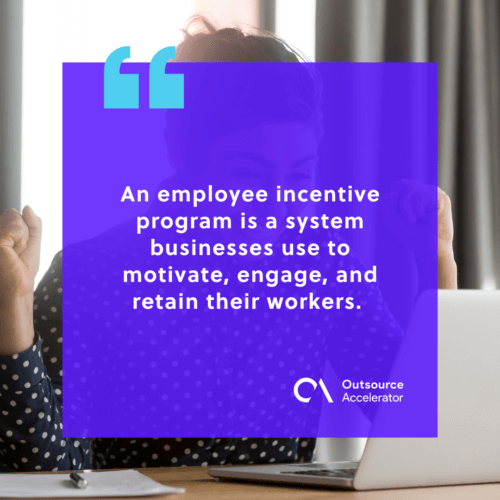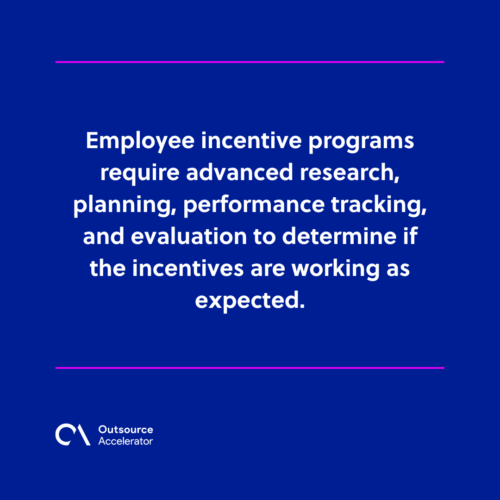10 Surefire employee incentive programs that work

The idea of working the same job for eight hours a day, five days a week, for about 50 weeks a year is an immense realization, no matter how much one loves their career.
There is always a risk of disengagement and burnout, and enough employees that experience that is a problem for the company.
A five-figure paycheck and dental benefits aren’t cutting it anymore. Industries must get creative, and crafting employee incentive programs are a reliable way to elevate the work culture.
What is an employee incentive program?
An employee incentive program is a system businesses use to motivate, engage, and retain their workers. This is considered a crucial component of human resource management.
In the corporate setting, employee incentive programs work by enabling organizations to cultivate targeted results by honoring the employees responsible.

What are incentives?
Incentives are rewards or benefits used to inspire positive behaviors and meet goals, in this case, in the workforce.
Employers can make their incentives in the form of either monetary or non-monetary rewards.
For the monetary ones, employers may choose to award cash bonuses and financial perks. For the latter, they may give things like mementos or intangible experiences like a more flexible schedule or a special day off.
There are three main objectives for employee incentive programs:
- Recognize. Employees should be considered pillars of your organization. Absent them, the machinery of the company ceases working.
- Reward. When employees are rewarded, it signifies to them that the company sees them as valuable and appreciative of their work.
- Retain. Many organizations that implement an employee incentive program see a greater retention rate than those that don’t. Workers are leaving their jobs at a much greater rate than ever, so employers should strive to innovate their ways to keep them.
To choose an effective employee incentive program, consider the wants and needs of the modern worker. You should also take into account whether the incentives you choose align with your company’s values.
For example, purchasing a liquor cake for every employee who makes a sale is probably not the best idea.
Employee incentive programs require advanced research, planning, performance tracking, and evaluation to determine if the incentives are working as expected. Incentive programs should also be customized and updated continuously.
A mix of both monetary and non-monetary incentives is encouraged.

Benefits of employee incentive programs
Employee incentive programs are effective because they leverage human behavior.
According to the incentive theory of motivation, actions are inspired by a desire to gain outside reinforcement. Essentially, rewards drive behavior.
Here are some of applying these programs to the workplace:
Boosted employee productivity
Rewarding those employees with outstanding performance motivates them to continue and inspire others to keep up. Having a fun end goal to work towards makes the effort to get there more worth it, enhancing their employee performance.
Increased business revenue
Employees who are engaged to perform through an incentive program will be more productive. Employee incentive programs help enhance the company’s bottom lines.
Increased employee retention
Employee incentives and monetary rewards create a workforce of happier employees who are more likely to stay with your company.
These plans are opportunities to boost employee morale, which is especially advantageous for keeping the best-performing employees.
Healthier company culture
Despite seemingly coming off as a “competition,” incentive programs improve company culture and office teamwork, as they foster cooperation, collaboration, and employee engagement.
Team-based rewards, in particular, contribute heavily to this.
10 employee incentive programs
Let’s now look at the most popular employee incentive programs that businesses use today:
1. Bonuses
Pure cash benefits are possibly the most common and fluid incentive to offer employees. With this program, the employer gives something they are sure the employee wants to receive.
There are different types of bonus programs:
Spot bonuses
These are small cash prizes given directly after an achievement. Bonuses are often given to workers who accomplished challenging tasks or have displayed exceptional work beyond their role.
Project bonuses
This type of employee incentive is more team-based. The company sets deadlines and criteria for teams to meet on a particular project.
The bonus is given when goals are reached. Because this program is team-based, there is great potential for a sense of camaraderie to be built up.
Performance bonuses
These are regularly scheduled rewards that an employee can receive for a remarkable work ethic. Its scheduled nature makes it easy for employers to track their workers’ efficacy.
Those who contribute directly to financial success are normally paid performance bonuses.
Employee retention bonuses
These are given to employees to encourage them to stay with the company for a specified period.
If a company experiences troubling times and is fearful of many resignations, the management may offer these types of employee benefits.
2. Referral programs
A referral program is a system where current employees source qualified candidates for the company’s job openings. Employers may create a tiered system where the incentive grows as the referred candidate advances further in the application.
3. Profit sharing
Profit sharing happens when a portion of the business’s net profits are shared directly with the employees. This practice is common among smaller and start-up businesses.
When the profits are tied to performance, employees can see how their actions directly impact the bottom line.
4. Professional development
Apart from proper compensation, many employees look for growth opportunities. Offering professional development shows that the organization believes that investing in their careers matters.
These forms of employee incentives programs promote a cycle of the business also progressing as the employees grow and learn.
5. Tuition reimbursement
Everyone should be continually learning, whether it’s the lowest-entry employee or the CEO. Many professionals today consider ongoing education a priority.
Offering to reimburse tuition for employees who take courses that will help them improve their skills is a good practice.
Alternatively, offering to help offset student loans will also build dedication to the company. Companies can also consider implementing a student debt relief plan.
6. Health and wellness
Workers are more concerned about their health now than ever. Investing in wellness programs will show employees that companies care about their well-being.
This goes beyond the customary health benefits many companies offer. Including perks in an incentive program further emphasizes the value it has.
These employee incentive plans may take the form of gym membership privileges or fitness centers, on-site exercise rooms, free nutritious meals, or health expert visits.
7. Additional time-off
Additional time off allows employees to gain a better work-life balance. Sometimes employees are willing to take a lower salary if it means more time off to recuperate and perform better.
Encourage employees to use their paid time off (PTO) and reward vacations to exceptional workers.
8. Remote working days
As nearly the whole world can now attest to, a remote set-up has allowed many to gain a much healthier work-life balance back. The flexibility that remote setup provides is a prized benefit many are now looking for.
A company should create systems that fit this to ensure employees still produce output.
- Provide laptops or devices for employees to work outside the office
- Invest in technology such as time-tracking applications or online conferencing software
- Come up with weekly objectives and plans
9. Year-end events
Hold special events for the team or company to create a culture of celebrating a year well done. Having festivities at a scheduled endpoint gives everyone something to look forward to if they perform their work well.
Reliable ideas for activities can include weekend trips, tours, and evening parties. A program with this is a foolproof way to inspire relationships and harmony among employees.
10. Gifts
Gifts can take many forms, and well-thought-out gifts are excellent incentives to reward employees. An organization may even arrange special gift-giving shows to recognize their workers.
A gift may be a plaque, trophy, or more casual items like gift certificates and concert tickets.
Effective employee incentive programs do well to engage employees and create an overall positive work experience. Businesses must always aim to be creative in ensuring their employees enjoy where and why they work.







 Independent
Independent




